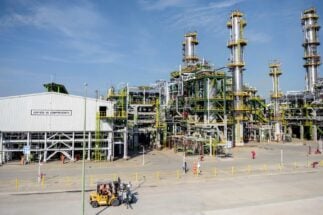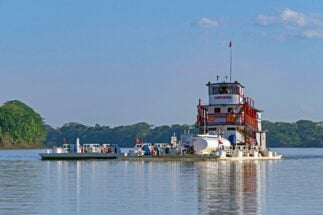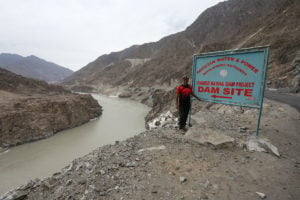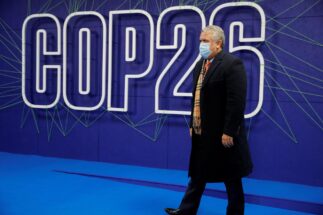With an estimated US$2.4 trillion in assets, most analysts consider it the world’s biggest public development bank. It has dished out almost US$100 billion in sovereign loans to Latin America in the past 15 years and injected tens of billions more into special regional financing programmes, according to US think-tank The Dialogue’s China-Latin America Finance Database.
Yet, few in the region know about China Development Bank (CDB).
With the bank supporting major energy and infrastructure projects that can entail considerable social and environmental risks, a new report by civil society organisation Latinoamérica Sustentable seeks to address the knowledge gap.
“CDB is a very important lender for various Latin American countries, but few people recognise the name,” said Paulina Garzón, director of Latinoamérica Sustentable. “Latin American governments are calling for investment in infrastructure and deepening extractivism [extracting raw materials for export] and, traditionally, these are two main areas of interest for the bank,” she added.
$31 billion
The amount (USD) that China Development Bank has invested in oil projects in Latin America
To date, CDB’s sovereign loan portfolio in Latin American has consisted overwhelmingly of finance for energy development. Of the US$38.8 billion it has channelled to the sector, oil accounts for $31 billion, according to Boston University data.
Despite CDB financing a range of projects, from controversial dams in Argentina to wind farms in Ecuador and oil refineries in Venezuela, the report notes the absence of publicly available social and environmental policies that render it accountable when projects breach local laws. Nor is there a channel for communities affected by projects to communicate their complaints, it says.
Among the documents analysed in the report are CDB’s available lending policies and seven loan contracts with Latin American governments. It found only two contracts that mentioned environmental law and none that included information regarding the environmental and social criteria considered in lending decisions.
For years, Chinese lenders have followed a policy of adhering to host country environmental laws, even where they are weak and not upheld by recipient countries. Recent developments in Chinese policy applicable to overseas investments, however, indicate greater proactivity and concern for environmental risk.
China Development Bank lending to Latin America
CDB lending to Latin America in the form of sovereign loans has declined sharply in recent years and it issued none to the region in 2020. Venezuela, Ecuador and Brazil account for 85% of the total. Aside from cutting off financial support for Venezuela, the drop doesn’t reflect a lack of interest in the wider region, according to Garzón.
Corporate loans direct to Chinese companies to support the purchase of other companies’ assets, or capital to participate in mining or oil concessions, are also common, she noted. CDB-backed companies also increasingly form public-private partnerships.
Although it started out in 1994 as a policy bank – a state-run bank tasked with supporting China’s overseas development goals – CDB was reclassified as a commercial bank in 2008. At this point, it ceased to be under the direct control of the State Council, China’s highest administrative authority, the report says.
Commercial banks are under the supervision of the banking regulator, now known as the China Banking and Insurance Regulatory Commission (CBIRC).
More than a step in the right direction?
The Latinoamérica Sustentable report notes that, before the end of this year, CBIRC is set to announce a grievance procedure for communities in host countries affected by Chinese banks’ projects.
“We value as a highly positive development that CBIRC has decided to establish a complaints mechanism. It’s a step in the right direction,” said Garzón. “No bank or corporation of any nationality can afford, even if it is just to stay in business, to completely ignore voices of protest and complaint.”
Liu Shuang, a senior finance associate at the World Resource Institute’s Sustainable Finance Center, said CBIRC’s movement towards addressing affected communities’ concerns will have direct consequences for the banks it regulates.
“Chinese lenders and their activities are very heavily influenced by other regulatory frameworks,” she said, adding that CBIRC’s new policy will be to encourage banks to develop their own governance system to address complaints.
Liu also pointed to a number of other recent policy developments in China that demonstrate a serious approach to social and environmental risk management overseas.
Among these are the advance of a recently proposed “traffic light” system by the Belt and Road Initiative Green Development Coalition (BRIGC) to classify investments according to their social and environmental risks and international climate and development goals. BRIGC is a group of Chinese and international experts that includes CBIRC’s policy chief Ye Yanfei.
The group recently launched a second round of recommendations and suggested that the system will require “a deep integration of environmental and social risk management into the core management systems and corporate strategy”.
Were this to develop into fully fledged policy, it would enable investors to benchmark their portfolios against clear criteria, Liu said.
The new guidelines will create more space for CDB to adopt more stringent environmental standards for overseas projects
Also notable are the Green Development Guidelines for Overseas Investment and Cooperation, issued jointly by China’s Ministry of Commerce and the Ministry of Ecology and Environment in July this year. The policy pledges to speed up “the greening of overseas investment and cooperation” and “build an economic system featuring green, low-carbon and circular development”.
“We believe that this [the guidelines] will create more space for CDB to adopt more stringent environmental standards for overseas projects,” Liu said, but added that changes are also necessary in host countries’ decision-making on development projects.
Project pipelines – the list of proposed projects that governments seek domestic and foreign investment for, and which include sovereign guarantees – strongly favour coal and other fossil fuels, Liu noted. When host country governments do call for greener investment, China responds.
Earlier this year, Bangladesh’s finance ministry sent a specific request to the Chinese embassy in Dhaka calling on it to cancel several coal-related projects. Shortly afterwards, the embassy confirmed that China would not invest in any coal-related projects in the country, the Financial Times reported.
Xi Jinping’s recent announcement that China would stop financing coal anywhere in the world and boost support for renewables was also an acknowledgement of international discussions of the issue, Liu said.
For Garzón, Xi’s overseas energy pledge was a reason to be hopeful: “All declarations by the Chinese government in favour of nature and the fight against climate change are very welcome.”









